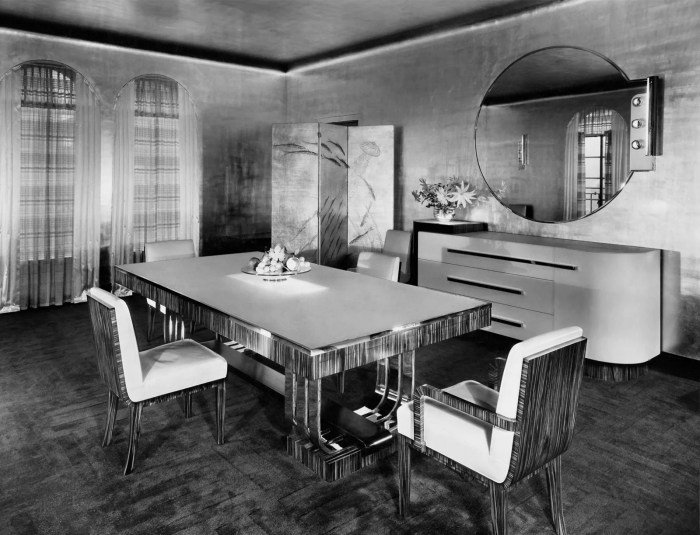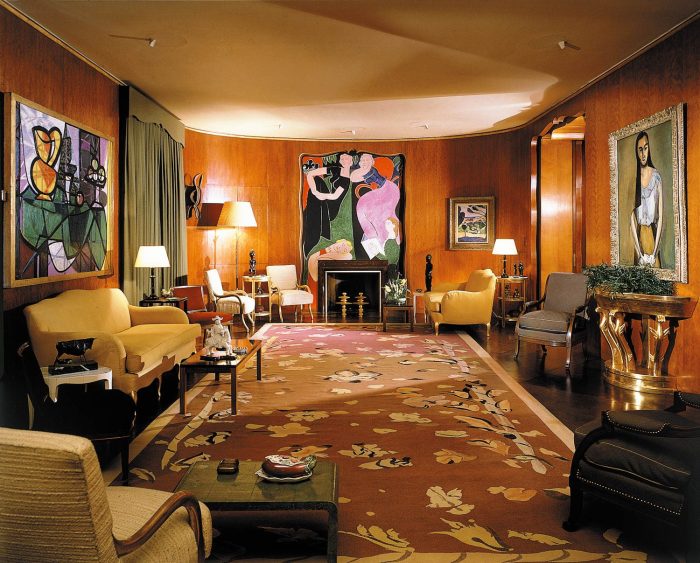Color Palettes and Materials of the Era

1930s home interior design – The 1930s, a decade bridging Art Deco’s glamour and the onset of World War II’s austerity, saw a fascinating interplay of opulent color palettes and a range of materials in interior design. The overall aesthetic leaned towards a sophisticated elegance, reflecting both the economic prosperity of the early years and the growing influence of streamlined modernism. This blend resulted in interiors that were both luxurious and functional.The dominant color palettes of the 1930s reflected the prevailing moods and styles of the time.
Rich, deep tones were favored, often complemented by lighter, contrasting shades. This created a sense of both drama and balance within the home environment. The use of color was often strategic, employed to highlight architectural details or to create a specific atmosphere in a room.
Prevalent Materials and Their Applications
Wood, metal, and fabrics played crucial roles in shaping the look and feel of 1930s interiors. The choice of materials often dictated the overall style of a room, whether it be the sophisticated elegance of Art Deco or the more streamlined simplicity of modernism. High-quality materials were frequently employed, reflecting the emphasis on craftsmanship and durability.Furniture was often crafted from richly grained woods like mahogany, walnut, and oak.
These woods were frequently polished to a high sheen, enhancing their natural beauty. Metal, particularly chrome and nickel, was incorporated into furniture legs, handles, and decorative accents, adding a touch of modernity and reflecting the era’s fascination with technology and industrial design. Fabrics included velvets, silks, and brocades, adding texture and luxuriousness to upholstery and drapery. These materials were often used in bold colors and patterns, complementing the rich wood tones and metallic accents.
Lacquer and Chrome in 1930s Design
Lacquer and chrome were two key elements that defined the aesthetic of 1930s design. Lacquer, with its high-gloss finish, was used extensively on furniture, particularly on pieces with streamlined or geometric forms. The reflective quality of lacquer enhanced the sense of modernity and sophistication. It was often used in conjunction with bold colors, further emphasizing the Art Deco influence.
Chrome, with its gleaming metallic surface, was employed in various applications, including furniture legs, decorative accents, and lighting fixtures. The use of chrome contributed to the clean, sleek lines that characterized much of the 1930s design. It symbolized the era’s technological advancements and its embrace of industrial aesthetics.
Sample Color Palette for a 1930s Living Room
A 1930s living room could effectively utilize a palette built around deep emerald green as the dominant wall color. This rich, jewel-toned hue evokes a sense of sophistication and luxury. To complement the emerald green, consider using a warm, creamy beige for the upholstery of a large sofa and armchairs. This neutral tone provides a comforting contrast to the deeper green, preventing the room from feeling overly dark or intense.
Accent pillows in a vibrant sapphire blue introduce a pop of color and a touch of Art Deco flair. Finally, touches of antique gold, perhaps in the framing of artwork or decorative elements, add a touch of metallic shimmer and further enhance the overall sense of opulence. The emerald green provides a grounding base, the beige offers a comfortable counterpoint, the sapphire blue brings a vibrant accent, and the gold adds a subtle touch of glamour.
This combination captures the spirit of the 1930s design aesthetic beautifully.
Furniture and Furnishings: 1930s Home Interior Design

The 1930s saw a fascinating evolution in furniture design, reflecting both the economic realities of the Great Depression and the burgeoning Art Deco and Streamline Moderne styles. Pieces were often characterized by a streamlined aesthetic, emphasizing clean lines and functionality, while still retaining elements of elegance and sophistication. This period showcases a blend of traditional craftsmanship with emerging industrial techniques, resulting in furniture that is both beautiful and durable.The shapes and silhouettes of 1930s furniture were largely defined by the prevailing design movements.
Art Deco’s influence is evident in the geometric forms, luxurious materials, and use of bold ornamentation. Streamline Moderne, on the other hand, emphasized smooth curves, aerodynamic shapes, and a sense of forward motion, often incorporating chrome and lacquer finishes. These styles often coexisted, leading to a rich variety of designs.
Iconic Furniture Pieces of the 1930s
Several iconic furniture pieces exemplify the design trends of the decade. These pieces are not only aesthetically pleasing but also represent significant advancements in furniture manufacturing and design philosophy. Their enduring appeal is a testament to their timeless elegance and enduring quality.
Comparison of 1930s and Modern Furniture
s furniture, while often elegant, prioritized functionality in a way that is sometimes overlooked in modern design. Many pieces were designed for multi-purpose use, reflecting the economic realities of the era. Modern furniture, while often sleek and minimalist, sometimes sacrifices practicality for aesthetics. Modern designs frequently emphasize individual pieces as standalone statements, whereas 1930s designs often focused on cohesive room arrangements and integrated storage solutions.
The materials used also differ significantly; 1930s furniture frequently used more solid wood and high-quality upholstery, while modern furniture often utilizes more manufactured materials and mass production techniques.
Typical 1930s Furniture Pieces, 1930s home interior design
The following list provides a glimpse into the variety of furniture prevalent in 1930s homes:
- Chesterfield Sofa: A classic design featuring a deep buttoned back and rolled arms, often upholstered in luxurious fabrics like velvet or leather. Its elegant form remained popular throughout the decade, reflecting a continuing appreciation for traditional styles, even within the context of modern design trends.
- Club Chairs: Comfortable armchairs with padded seats and arms, often featuring curved or rounded shapes reflecting the Streamline Moderne style. These chairs were ideal for relaxation and conversation, fitting perfectly into the more intimate social settings of the era.
- Vanity Tables: Often featuring Art Deco-inspired geometric designs and mirrored surfaces, these pieces provided a glamorous touch to the bedroom. The incorporation of mirrors was practical as well, reflecting a focus on both beauty and functionality.
- Cocktail Tables: Low tables designed to accommodate drinks and snacks, often featuring chrome legs and glass or lacquer tops, showcasing the sleek lines of Streamline Moderne design. These tables were emblematic of the burgeoning social scene of the era, reflecting a shift towards more casual entertaining.
- Radio Consoles: These large pieces incorporated radios into elegant cabinets, highlighting the growing importance of radio in daily life. The ornate designs and high-quality materials reflect the status symbol the radio had become.
Question & Answer Hub
What were some common lighting fixtures used in 1930s homes?
Common lighting fixtures included ornate chandeliers, table lamps with geometric bases, and wall sconces featuring frosted glass or metallic accents.
How did the use of technology influence 1930s kitchen design?
The rise of electric appliances like refrigerators and stoves led to more efficient and streamlined kitchen layouts, often incorporating built-in cabinetry.
Were there any specific wallpaper patterns popular in the 1930s?
Geometric patterns, stylized floral designs, and Art Deco-inspired motifs were popular wallpaper choices.
What role did rugs and carpets play in 1930s interior design?
Rugs and carpets often added warmth and color, sometimes featuring geometric or abstract patterns that complemented the overall design scheme.
